Ypres Reservoir Cemetery, Ieper - Belgium
Three military cemeteries were established during the war close to the Ypres waterworks and prison. Only one of the three cemeteries is now in existance. The three original cemeteries were:
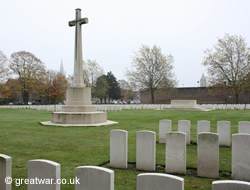
|
- Ypres Reservoir South Cemetery: located between the prison and the reservoir (also called “Broadley's Cemetery” and “Prison Cemetery No. 1”).
- Ypres Reservoir Middle Cemetery: located north of Ypres Reservoir South Cemetery (also called “Prison Cemetery No. 2” and “Middle Prison Cemetery”).
- Ypres Reservoir North Cemetery: located north of the prison (also called “Cemetery North of the Prison”).
Ypres Reservoir North Cemetery was started in October 1915. The burials it contained were men who had died in military units fighting in the Ypres Salient and men who had died of their wounds in the Casualty Clearing Stations. By November 1918 there were 1,099 graves.
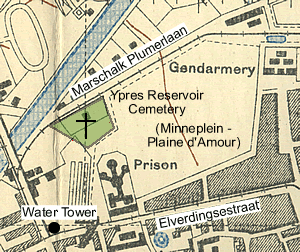 |
After the war the 18 burials in Ypres Reservoir South and the 107 burials in the Ypres Reservoir Middle Cemetery were moved into Ypres Reservoir North Cemetery. In addition, 14 graves were brought in from a small cemetery at the Infantry Barracks (also called “The Esplanade”). When the battlefields were cleared after the war many soldiers buried graves in individual plots and small cemeteries in and around the town were brought into this larger burial ground from the battlefields of the Ypres Salient. The enlarged cemetery was renamed “Ypres Reservoir Cemetery”. It was designed by Sir Reginald Blomfield.
2,613 Commonwealth servicemen are now buried in this cemetery. 1,579 of the graves are identified with 1,034 graves containing the remains of unidentified burials.
The Plaine d’Amour - Minneplein
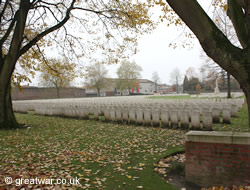
|
The Ypres Reservoir Cemetery is located in the northern section of a piece of ground in the north part of Ypres that up to 1914 was a large, grassed area known by its French name of the “Plaine d’Amour” or its Flemish name of “Minneplein”. This grassy area lay between one of the inner and outer old fortified walls of the town. When the Dutch had been in charge of the administration of Ypres between 1814 and 1830 the fortifications in the north-west part of the town had been removed. Officially called the “Plaine d'Armes” it is said that the French name of “Plaine d'Amour” was derived from this by the French-speaking locals. It had become a peaceful place of recreation. As a large open space it was well used by the local people as a place to walk, play and picnic on. Animals grazed on it too.
In 1919 the Belgian government, in association with the King Albert Fund, put up lots of wooden prefabricated huts on the Plaine d'Amour, or Minneplein, and other open spaces so that the local people returning to their ruined town had shelter and somewhere to live.
Today a part of the Minneplein is still used for recreation; it is the location of the town football ground. A school is located in the former north-east corner of it, next to the Ypres Reservoir Cemetery.
Casualties Buried in this Cemetery
Brigadier General Francis A Maxwell, V.C., C.S.I., D.S.O.
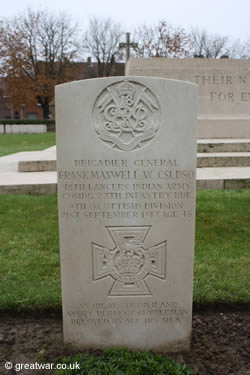
|
Brigadier General Maxwell was killed on 21 September 1917 while commanding the 27th Infantry Brigade in the 9th (Scottish) Division. He was 46 years old. Francis Maxwell had served in the Second Boer War as a Lieutenant with the cavalry regiment Roberts' Light Horse. For his gallantry in action at Sanna's Post on 31 March 1900 during the 2nd Boer War he had been awarded the Victoria Cross. Brigadier General Maxwell was a brave officer who had had a glittering military career.
Brigadier Maxwell is buried in Plot I, Row A, Grave 37 (the grave location is in the row of graves immediately beyond the War Stone as you approach it from the Great Cross.)
Casualties in the Cathedral Vaults, 1915
There are a number of graves in this cemetery of a group of soldiers who were killed or died of wounds as a result of German shelling onto the city of Ypres in 1915. In August of that year men of the 6th Battalion Duke of Cornwall's Light Infantry (D.C.L.I.) were billeted in the town after having been involved in the battle to hold the line at Hooge. This was a battle when the Germans used flame throwers for the first time. While the battalion was out of the line and in reserve, about 40 men were resting in the vaults of St. Martin’s Cathedral.
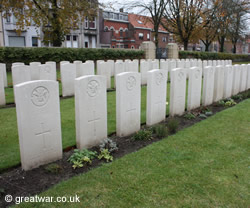
|
On 12 August the city of Ypres was shelled continuously for several hours by the German artillery. Many of the D.C.L.I. men were buried under rubble in the vaults as the ceilings collapsed. Two of the battalion's officers, Major Barnett and Lieutenant Blagrove, assisted men of the 11th Battalion the King's Liverpool Regiment in an attempt to dig them out. Some were rescued alive but 22 men are listed as having died on that day in the battalion. Three more are listed as having died of wounds in the following five days, although it is not certain if injuries were sustained in this incident in Ypres. The bodies which could not be retrieved at that time were discovered in the rubble of the vaults when the war was over and the ruins of the city were cleared.
The remains of 16 men of the 6th Battalion the Duke of Cornwall’s Light Infantry (D.C.L.I.) are laid to rest at grave reference Plot V, Row AA, Grave 1. Five other casualties who died on 12 August as a result of this incident, including Major Barnett and the battalion adjutant Lieutenant Blagrove, are buried in the cemetery at Plot X, Row D, Grave references 18-21. Another D.C.L.I. casualty of 12 August, Private William J Smith, is buried in Plot IX, Row F, Grave reference 26.
Location
Plumerlaan 15, 8900 Ieper, Belgium
Latitude 50.853685; Longitude 2.877280
The Ypres Reservoir Cemetery is located on the Plumerlaan, about 10-15 minutes' walk from the Grote Markt (market square) in the centre of Ieper.
Related Reading

The Boer War
by Thomas Pakenham
This is a comprehensive and acclaimed history of the Boer War using first-hand accounts. It includes the part played by Brigadier General Francis A Maxwell, V.C., C.S.I., D.S.O.
Related Topics
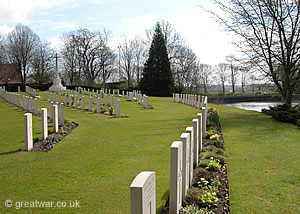
|
There are over 120 British and Commonwealth military cemeteries in the Ypres Salient, several major memorials to the missing, one German military cemetery and two French military cemeteries. For listings and locations see our pages at:
Cemeteries in the Ypres Salient
Monuments and Memorials in the Ypres Salient
Acknowledgements
Some of the cemetery description and history has been sourced by kind permission of The Commonwealth War Graves Commission (CWGC). For more information about the cemeteries and the work of the commission visit the CWGC website:
Website: www.cwgc.org
